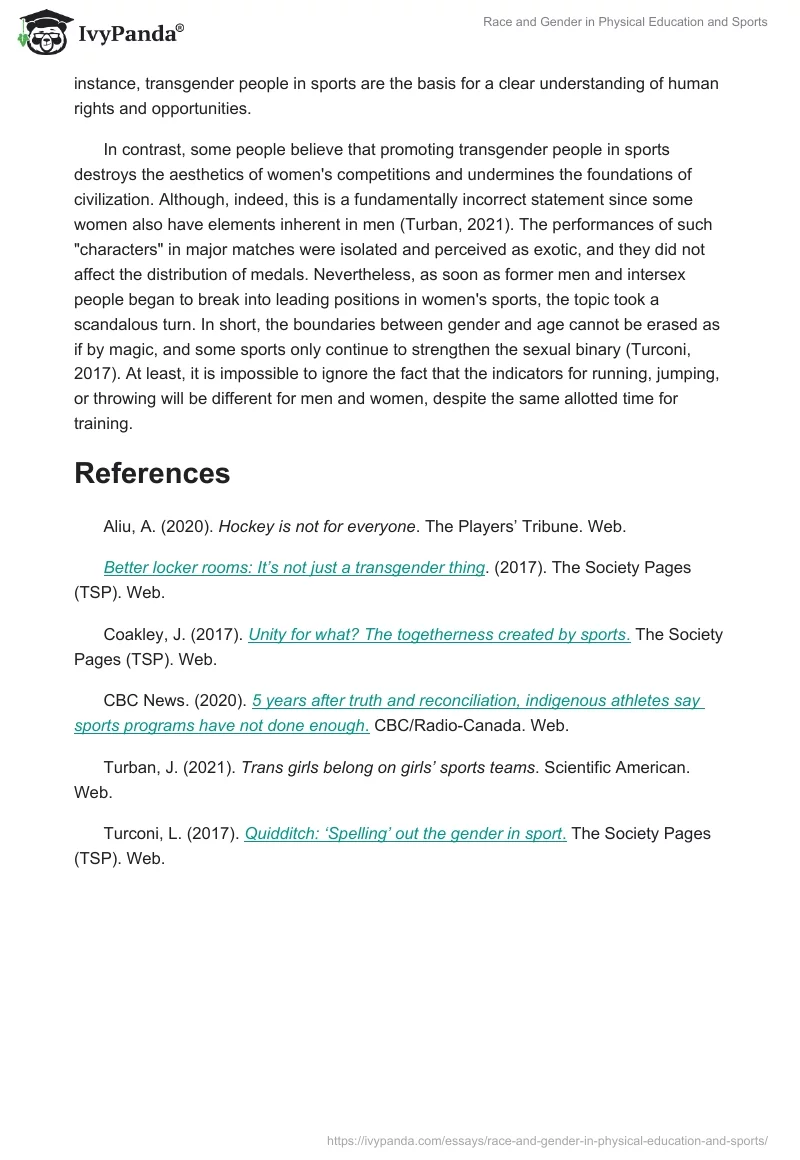One should mention that race and gender play a primary role in physical education and sports. Perhaps these are some of the most significant characteristics without which it would be impossible to develop and promote sport and physical activity. These factors create the diversity of cultures and nations, and inclusiveness, giving access to the best talents and disclosing the individual’s potential, abilities, and strengths.
Sport unites and connects people, regardless of personal, physical, or mental qualities. It is enough to look at how people of various skin tones, other origins, and regions work together in one team, glorifying each other, rejoicing, or grieving together (Coakley, 2017). Sport has imperceptibly changed the consciousness, and mentality of citizens, forcing them to think about themselves and the individuals around them (Coakley, 2017). In particular, sport is not just enjoyment and an escape from routine but also a way to unite citizens regardless of race, gender, nationality, and other elements.
Nevertheless, the inner part and the “underside” of sport are not what it seems at first glance. Hence, based on the experience of the famous hockey player, one must remark that hazing and discrimination based on nationality actively continue to flourish in sports (Aliu, 2020). Viewers cannot participate in the feelings and sensations shared by young athletes, particularly at the beginning of their careers. These athletes can be gifted, talented, different, and unlike each other; in some way, based on pluralism and diversity, a conflict may arise within a team. In addition, all races on Earth have their peculiarities of physiology, and this is noticeable both externally and in the results of sports competitions.
Often, not only race and age remain the subject of discussion, but also the identification of some individuals. Sports principles have turned out to be almost the main stronghold of “sexism,” “ageism,” and “racism.” If earlier sport was divided exclusively into “male” and “female.” Still, this concept remains in doubt at the moment due to rapidly changing trends and the high dynamics of social development. For instance, transgender people in sports are the basis for a clear understanding of human rights and opportunities.
In contrast, some people believe that promoting transgender people in sports destroys the aesthetics of women’s competitions and undermines the foundations of civilization. Although, indeed, this is a fundamentally incorrect statement since some women also have elements inherent in men (Turban, 2021). The performances of such “characters” in major matches were isolated and perceived as exotic, and they did not affect the distribution of medals. Nevertheless, as soon as former men and intersex people began to break into leading positions in women’s sports, the topic took a scandalous turn. In short, the boundaries between gender and age cannot be erased as if by magic, and some sports only continue to strengthen the sexual binary (Turconi, 2017). At least, it is impossible to ignore the fact that the indicators for running, jumping, or throwing will be different for men and women, despite the same allotted time for training.
References
Aliu, A. (2020). Hockey is not for everyone. The Players’ Tribune. Web.
Better locker rooms: It’s not just a transgender thing. (2017). The Society Pages (TSP). Web.
Coakley, J. (2017). Unity for what? The togetherness created by sports. The Society Pages (TSP). Web.
CBC News. (2020). 5 years after truth and reconciliation, indigenous athletes say sports programs have not done enough. CBC/Radio-Canada. Web.
Turban, J. (2021). Trans girls belong on girls’ sports teams. Scientific American. Web.
Turconi, L. (2017). Quidditch: ‘Spelling’ out the gender in sport. The Society Pages (TSP). Web.


